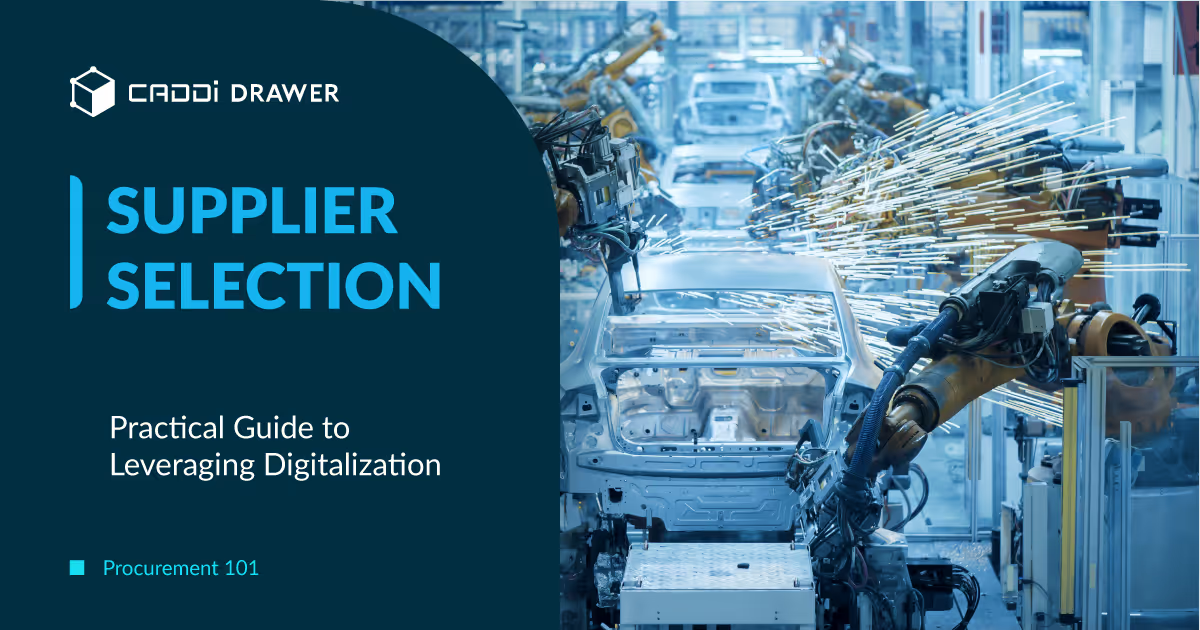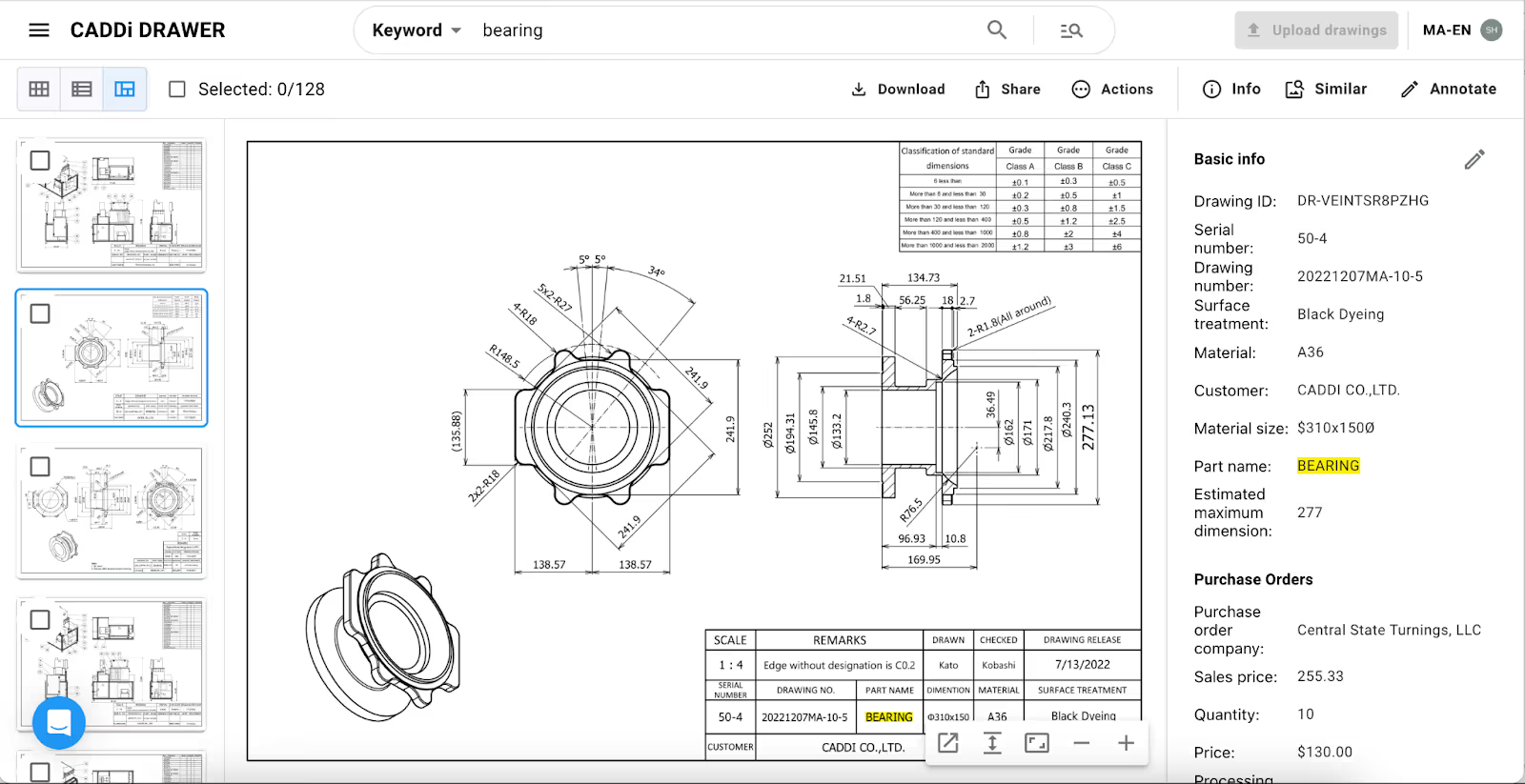Procurement 101: Supplier Selection – Practical Guide to Leveraging Digitalization

Table of Contents

Key Components of Supplier Selection
Supplier selection is a critical process that can make or break your supply chain. Just like choosing the right ingredients for a recipe, selecting the right suppliers is essential for ensuring the quality, reliability, and cost-effectiveness of your products or services. Here are the key steps and factors to consider when selecting suppliers:
Basic Steps of Supplier Selection are:
- Define your requirements: Clearly outline what you need from a supplier, including product specifications, quantities, delivery timelines, and quality standards.
- Identify potential suppliers: Research and create a list of suppliers that meet your basic criteria, such as industry expertise, location, and size.
- Request for information (RFI): Reach out to potential suppliers with an RFI to gather more details about their capabilities, experience, and pricing.
- Evaluate and shortlist suppliers: Assess the responses from suppliers based on your criteria and create a shortlist of the most promising candidates.
- Request for quotation (RFQ): Send a detailed RFQ to shortlisted suppliers to get specific proposals or bids for your project.
- Negotiate and select suppliers: Evaluate the proposals, negotiate terms and conditions, and select the supplier(s) that best meet your needs.
- Contract and onboard suppliers: Finalize contracts with selected suppliers and onboard them into your supply chain processes.
Key Factors for Success in Supplier Selection
1. Clear and comprehensive requirements: The foundation of successful supplier selection is a clear understanding of what you need. Be specific and detailed in your requirements to avoid misunderstandings or misaligned expectations. Ensure that the supplier’s quotation reflects all the requested conditions, especially if the purchasing conditions were difficult to formulate.
2. Rigorous evaluation criteria: Establish a set of objective criteria to evaluate suppliers, such as quality, cost, delivery, innovation, and sustainability. Use a weighted scoring system to prioritize the factors that matter most to your business. Confirm the supplier’s ability to meet these criteria and their compatibility with the quotation conditions.
3. QCD balance: Supplier selection should be based on the balance of QCD (Quality, Cost, and Delivery). While cost is an important factor, it is closely tied to quality and delivery time. If a significantly low (or high) quotation is submitted, investigate the reasons behind the price difference and assess the compatibility with the ordering conditions.
4. Due diligence and continuous negotiation: Conduct thorough due diligence, including financial checks, references, site visits, and sample testing, to verify suppliers’ claims and capabilities. If multiple suppliers offer the same price, continue price negotiations to secure more favorable prices. However, ensure that the selected supplier is the most compatible with the provided conditions.
5. Alignment with business strategy: Select suppliers that align with your overall business strategy and values. Consider factors such as innovation, sustainability, and social responsibility, which can impact your brand reputation and long-term success.
6. Relationship building: Supplier selection is not just a one-time transaction, but the beginning of a long-term relationship. Choose suppliers that are willing to collaborate, communicate openly, and continuously improve. Leverage the timing of supplier selection to extract the most concessions from suppliers.
7. Risk management and root cause investigation: Assess and mitigate potential risks associated with each supplier, such as financial stability, intellectual property, and supply chain disruptions. Have contingency plans in place to manage any issues that may arise. If an attractively low quotation is submitted, investigate the reasons behind it and assess the risks. In some cases, it may be necessary to select a higher-priced supplier based on the overall balance.
8. Accountability for selection rationale: The procurement and purchasing department must comprehensively evaluate the feasibility of the provided purchase specifications and determine the supplier to place the order with. Supplier selection is the most important decision made by the buyer. A competent buyer should be able to clearly explain the reasons for selecting a particular supplier, demonstrating the chosen supplier’s compliance with the conditions provided by internal related departments, including Quality and Delivery compatibility.
By considering these key factors and following a thorough supplier selection process, manufacturers can build strong, resilient supply chains that contribute to their long-term success. Remember, the cheapest option is not always the best, and a comprehensive evaluation of QCD balance, compatibility with requirements, and risk management is crucial in making the right supplier choice.
The need to digitize the supplier selection process
Supplier selection often faces common pitfalls, including:
- Over-emphasizing cost savings while neglecting quality and reliability
- Lack of comprehensive vendor data for informed decision-making
- Insufficient collaboration among stakeholders, leading to misaligned priorities
- Inadequate risk assessment and monitoring of supplier performance
- Time-consuming manual processes prone to human error
To address these challenges, digitizing the supplier selection process has become essential. Digital platforms enable the collection and analysis of extensive vendor data, facilitating data-driven decisions based on multiple criteria.
They foster collaboration and transparency among stakeholders, ensuring alignment on supplier requirements. Real-time risk monitoring and performance tracking help proactively mitigate potential issues. Furthermore, digital tools automate manual tasks, reducing time and errors.
A Practical Guide to Digitalizing Your Supplier Selection Process
Imagine you’re the procurement manager at ABC Manufacturing, a company that produces high-precision components for the automotive industry. You’ve been tasked with digitalizing and streamlining the supplier selection process to improve efficiency, reduce costs, and mitigate risks. Here’s a step-by-step guide to help you achieve this goal:
1: Define Your Requirements and Criteria
- Clearly outline your sourcing requirements, including product specifications, quality standards, delivery timelines, and target costs
- Establish a set of objective criteria for evaluating suppliers, such as financial stability, production capacity, technical capabilities, and sustainability practices
- Assign weights to each criterion based on their importance to your business objectives
2: Implement a Supplier Relationship Management (SRM) System
- Invest in a cloud-based SRM system, such as SAP Ariba, Oracle Supplier Management, or Coupa, to centralize supplier data and automate key processes
- Migrate your existing supplier data into the SRM system, ensuring data accuracy and completeness
- Configure the system to align with your defined requirements and criteria, including custom fields and workflows
3: Digitalize the RFQ Processes
- Create digital RFQ templates within your SRM system, incorporating your predefined requirements and criteria
- Utilize the system’s collaboration features to involve cross-functional stakeholders in the RFQ development process
- Launch the RFQ through the SRM system, leveraging its supplier portal and communication tools to streamline the process
4: Conduct Digital Supplier Audits and Assessments
- Utilize your SRM system’s survey and assessment features to conduct digital supplier audits and performance evaluations
- Develop a set of standardized questions and criteria to assess supplier capabilities, quality management systems, and continuous improvement initiatives
- Conduct online audit meetings with suppliers and online factory tours to assess supplier capability, facilities and production processes remotely through video conferencing tools
- Analyze supplier responses and performance data within the SRM system, using built-in analytics and reporting tools
5: Make Data-Driven Supplier Decisions
- Utilize your SRM system’s decision support tools, such as weighted scoring and scenario analysis, to objectively evaluate suppliers based on your predefined criteria
- Collaborate with cross-functional stakeholders through the system’s workflow and approval features to ensure alignment and buy-in
- Communicate supplier decisions and feedback through the SRM system’s supplier portal, fostering transparency and trust
By following these steps and leveraging the right digital tools, ABC Manufacturing can transform its supplier selection process from a manual, time-consuming endeavor to a streamlined, data-driven, and risk-aware process. The key is to embrace digitalization not as a one-time project but as a continuous journey of improvement and innovation, ultimately leading to stronger supplier relationships and a more resilient supply chain.
Elevate Your Supplier Decisions with CADDi Drawer
As you digitalize your supplier selection process, consider leveraging CADDi Drawer to make data-driven decisions. Here’s how it can help:
Uncover Hidden Opportunities
- Utilize similarity search to identify part categories for consolidation
- Automatically link price and supplier data to drawings

Streamline Procurement Tasks
- Reduce time spent searching for drawings and data
- Export price and supplier information with ease

Learn from Industry Leaders
- Kawasaki Railcar Manufacturing: Achieved unexpected cost reductions
- Ebara Corporation: Leveraged buried data for optimal procurement
CADDi Drawer acts as a digital magnifying glass, revealing insights within your drawings and purchasing data. It’s like having a smart assistant and librarian combined, helping you uncover patterns and locate information quickly.
Don’t just take our word for it – industry leaders are already harnessing the power of CADDi Drawer to drive their strategic sourcing initiatives.
Key Components of Supplier Selection
Supplier selection is a critical process that can make or break your supply chain. Just like choosing the right ingredients for a recipe, selecting the right suppliers is essential for ensuring the quality, reliability, and cost-effectiveness of your products or services. Here are the key steps and factors to consider when selecting suppliers:
Basic Steps of Supplier Selection are:
- Define your requirements: Clearly outline what you need from a supplier, including product specifications, quantities, delivery timelines, and quality standards.
- Identify potential suppliers: Research and create a list of suppliers that meet your basic criteria, such as industry expertise, location, and size.
- Request for information (RFI): Reach out to potential suppliers with an RFI to gather more details about their capabilities, experience, and pricing.
- Evaluate and shortlist suppliers: Assess the responses from suppliers based on your criteria and create a shortlist of the most promising candidates.
- Request for quotation (RFQ): Send a detailed RFQ to shortlisted suppliers to get specific proposals or bids for your project.
- Negotiate and select suppliers: Evaluate the proposals, negotiate terms and conditions, and select the supplier(s) that best meet your needs.
- Contract and onboard suppliers: Finalize contracts with selected suppliers and onboard them into your supply chain processes.
Key Factors for Success in Supplier Selection
1. Clear and comprehensive requirements: The foundation of successful supplier selection is a clear understanding of what you need. Be specific and detailed in your requirements to avoid misunderstandings or misaligned expectations. Ensure that the supplier’s quotation reflects all the requested conditions, especially if the purchasing conditions were difficult to formulate.
2. Rigorous evaluation criteria: Establish a set of objective criteria to evaluate suppliers, such as quality, cost, delivery, innovation, and sustainability. Use a weighted scoring system to prioritize the factors that matter most to your business. Confirm the supplier’s ability to meet these criteria and their compatibility with the quotation conditions.
3. QCD balance: Supplier selection should be based on the balance of QCD (Quality, Cost, and Delivery). While cost is an important factor, it is closely tied to quality and delivery time. If a significantly low (or high) quotation is submitted, investigate the reasons behind the price difference and assess the compatibility with the ordering conditions.
4. Due diligence and continuous negotiation: Conduct thorough due diligence, including financial checks, references, site visits, and sample testing, to verify suppliers’ claims and capabilities. If multiple suppliers offer the same price, continue price negotiations to secure more favorable prices. However, ensure that the selected supplier is the most compatible with the provided conditions.
5. Alignment with business strategy: Select suppliers that align with your overall business strategy and values. Consider factors such as innovation, sustainability, and social responsibility, which can impact your brand reputation and long-term success.
6. Relationship building: Supplier selection is not just a one-time transaction, but the beginning of a long-term relationship. Choose suppliers that are willing to collaborate, communicate openly, and continuously improve. Leverage the timing of supplier selection to extract the most concessions from suppliers.
7. Risk management and root cause investigation: Assess and mitigate potential risks associated with each supplier, such as financial stability, intellectual property, and supply chain disruptions. Have contingency plans in place to manage any issues that may arise. If an attractively low quotation is submitted, investigate the reasons behind it and assess the risks. In some cases, it may be necessary to select a higher-priced supplier based on the overall balance.
8. Accountability for selection rationale: The procurement and purchasing department must comprehensively evaluate the feasibility of the provided purchase specifications and determine the supplier to place the order with. Supplier selection is the most important decision made by the buyer. A competent buyer should be able to clearly explain the reasons for selecting a particular supplier, demonstrating the chosen supplier’s compliance with the conditions provided by internal related departments, including Quality and Delivery compatibility.
By considering these key factors and following a thorough supplier selection process, manufacturers can build strong, resilient supply chains that contribute to their long-term success. Remember, the cheapest option is not always the best, and a comprehensive evaluation of QCD balance, compatibility with requirements, and risk management is crucial in making the right supplier choice.
The need to digitize the supplier selection process
Supplier selection often faces common pitfalls, including:
- Over-emphasizing cost savings while neglecting quality and reliability
- Lack of comprehensive vendor data for informed decision-making
- Insufficient collaboration among stakeholders, leading to misaligned priorities
- Inadequate risk assessment and monitoring of supplier performance
- Time-consuming manual processes prone to human error
To address these challenges, digitizing the supplier selection process has become essential. Digital platforms enable the collection and analysis of extensive vendor data, facilitating data-driven decisions based on multiple criteria.
They foster collaboration and transparency among stakeholders, ensuring alignment on supplier requirements. Real-time risk monitoring and performance tracking help proactively mitigate potential issues. Furthermore, digital tools automate manual tasks, reducing time and errors.
A Practical Guide to Digitalizing Your Supplier Selection Process
Imagine you’re the procurement manager at ABC Manufacturing, a company that produces high-precision components for the automotive industry. You’ve been tasked with digitalizing and streamlining the supplier selection process to improve efficiency, reduce costs, and mitigate risks. Here’s a step-by-step guide to help you achieve this goal:
1: Define Your Requirements and Criteria
- Clearly outline your sourcing requirements, including product specifications, quality standards, delivery timelines, and target costs
- Establish a set of objective criteria for evaluating suppliers, such as financial stability, production capacity, technical capabilities, and sustainability practices
- Assign weights to each criterion based on their importance to your business objectives
2: Implement a Supplier Relationship Management (SRM) System
- Invest in a cloud-based SRM system, such as SAP Ariba, Oracle Supplier Management, or Coupa, to centralize supplier data and automate key processes
- Migrate your existing supplier data into the SRM system, ensuring data accuracy and completeness
- Configure the system to align with your defined requirements and criteria, including custom fields and workflows
3: Digitalize the RFQ Processes
- Create digital RFQ templates within your SRM system, incorporating your predefined requirements and criteria
- Utilize the system’s collaboration features to involve cross-functional stakeholders in the RFQ development process
- Launch the RFQ through the SRM system, leveraging its supplier portal and communication tools to streamline the process
4: Conduct Digital Supplier Audits and Assessments
- Utilize your SRM system’s survey and assessment features to conduct digital supplier audits and performance evaluations
- Develop a set of standardized questions and criteria to assess supplier capabilities, quality management systems, and continuous improvement initiatives
- Conduct online audit meetings with suppliers and online factory tours to assess supplier capability, facilities and production processes remotely through video conferencing tools
- Analyze supplier responses and performance data within the SRM system, using built-in analytics and reporting tools
5: Make Data-Driven Supplier Decisions
- Utilize your SRM system’s decision support tools, such as weighted scoring and scenario analysis, to objectively evaluate suppliers based on your predefined criteria
- Collaborate with cross-functional stakeholders through the system’s workflow and approval features to ensure alignment and buy-in
- Communicate supplier decisions and feedback through the SRM system’s supplier portal, fostering transparency and trust
By following these steps and leveraging the right digital tools, ABC Manufacturing can transform its supplier selection process from a manual, time-consuming endeavor to a streamlined, data-driven, and risk-aware process. The key is to embrace digitalization not as a one-time project but as a continuous journey of improvement and innovation, ultimately leading to stronger supplier relationships and a more resilient supply chain.
Elevate Your Supplier Decisions with CADDi Drawer
As you digitalize your supplier selection process, consider leveraging CADDi Drawer to make data-driven decisions. Here’s how it can help:
Uncover Hidden Opportunities
- Utilize similarity search to identify part categories for consolidation
- Automatically link price and supplier data to drawings

Streamline Procurement Tasks
- Reduce time spent searching for drawings and data
- Export price and supplier information with ease

Learn from Industry Leaders
- Kawasaki Railcar Manufacturing: Achieved unexpected cost reductions
- Ebara Corporation: Leveraged buried data for optimal procurement
CADDi Drawer acts as a digital magnifying glass, revealing insights within your drawings and purchasing data. It’s like having a smart assistant and librarian combined, helping you uncover patterns and locate information quickly.
Don’t just take our word for it – industry leaders are already harnessing the power of CADDi Drawer to drive their strategic sourcing initiatives.
Ready to see CADDi Drawer in action? Get a personalized demo.
Subscribe to our Blog!
Related Resources












.svg)



.svg)
.svg)
.svg)


